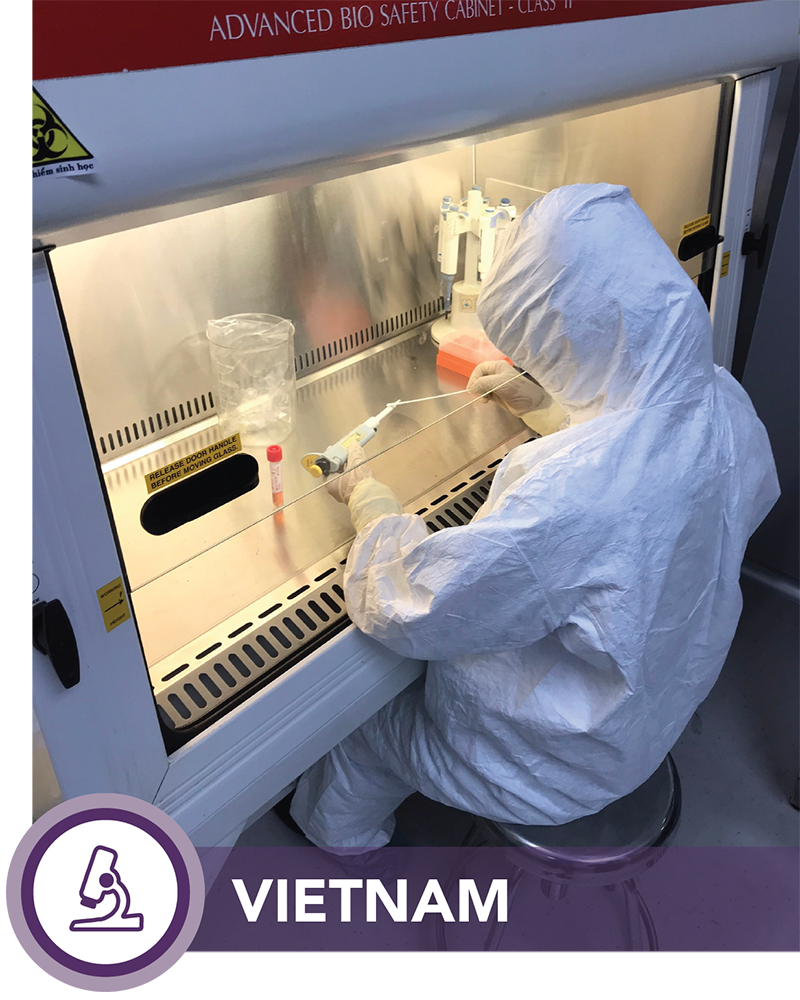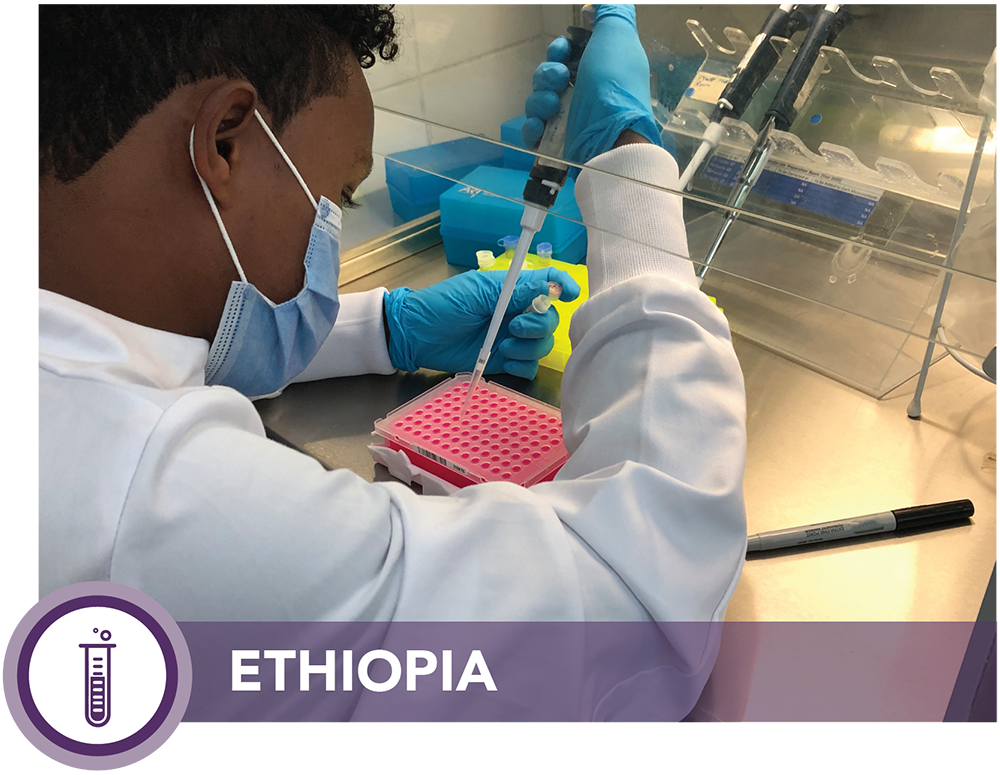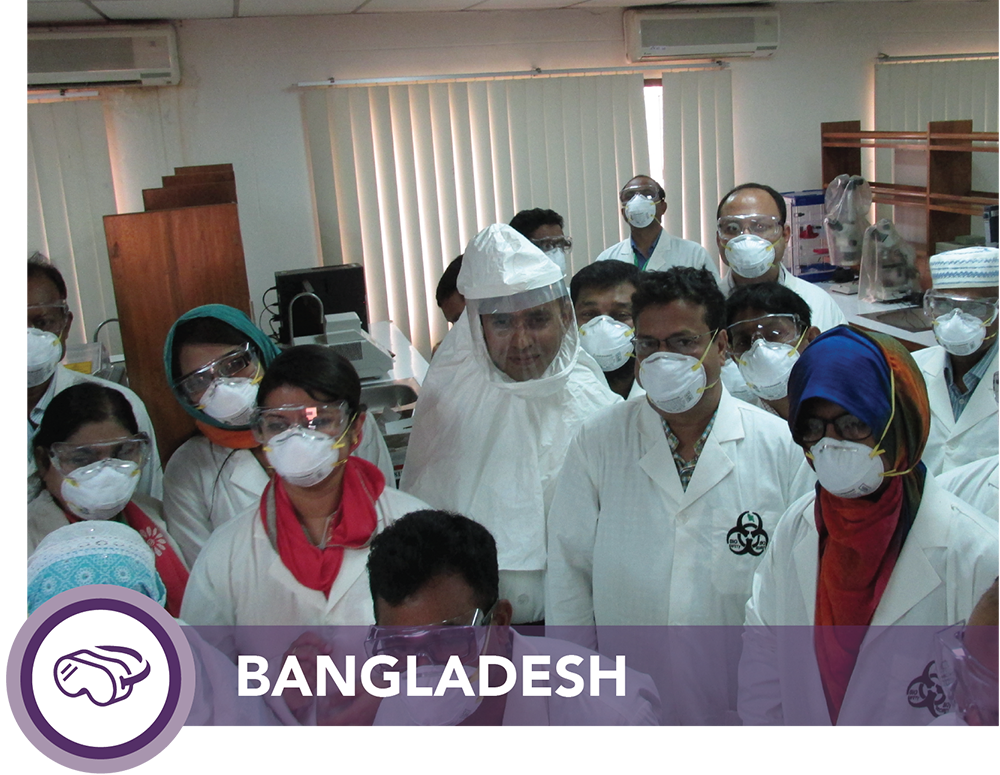Laboratory Commitments and Innovations Pay Off
December 8, 2020
Why Invest in Laboratories?
As the COVID-19 pandemic continues to surge around the world, it is essential to quickly test and diagnose illness. Now more than ever, laboratories are a critical component of every country’s core capacity for emergency response. To improve global health security, CDC works with over 45 countries and regions, developing and supporting quicker, safer, and more effective laboratories for rapid response during public health emergencies.
CDC’s expertise, investments, and alliances with partners make it possible for laboratories across the globe to respond to infectious disease outbreaks. Through training and innovations in diagnostic testing, infrastructure development, biosafety and biosecurity, countries like Vietnam, Ethiopia, and Bangladesh are better able to meet the challenges of COVID-19.

Disinfecting a pipette surface within a biosafety cabinet after processing and testing a sample at the Pasteur Institute of Nha Trang (PINT) laboratory in Vietnam. Photo: Mr. Truong Tien Dat, CDC Vietnam
From the onset of the COVID-19 pandemic, Vietnam quickly developed and put into place a laboratory testing strategy to protect communities and prevent the spread of the virus. Building on 22 years of cooperation, CDC experts worked with the Ministry of Health to enhance Vietnam’s laboratory capacity through guidance and research on COVID-19 testing methods and resources. Through this partnership, CDC worked with the National Institute of Hygiene and Epidemiology (NIHE) to establish the National Public Health Reference Laboratory in Vietnam. This collaboration also supported training on COVID-19 sample collection and testing for staff at regional public health institutes, hospitals, and animal health laboratories.
Vietnam’s laboratory strategy successfully limited the spread of COVID-19 in the country to just over 1,305 cases reported on November 24th. Additionally, Vietnam was able to expand diagnostic testing, which helped reduce transmission within high-risk communities. Vietnam’s accomplishments demonstrate how laboratory investments help prepare countries to develop and implement a rapid response during a public health emergency.

Laboratory scientist processes and tests COVID-19 specimens at the Ethiopian Public Health Institute. Photo: Anne Purfield, CDC Ethiopia
In the wake of the COVID-19 pandemic, previous investments in global laboratories have become invaluable. For more than two decades, CDC has worked with the Government of Ethiopia to enhance laboratory capacity and strengthen the country’s overall public health infrastructure. In response to COVID-19, CDC supported Ethiopia’s diagnostic testing efforts and strengthened a National Public Health Reference Laboratory by verifying test kits, establishing a laboratory quality assurance program, and facilitating the procurement of emergency supplies. Additionally, CDC laboratory staff in Ethiopia helped develop testing strategies and indicators to compare performance across laboratories.
While Ethiopia initially sent COVID-19 samples abroad for testing, the country now tests thousands of specimens per day through its own laboratories. These activities led to the rapid expansion of testing and increased the country’s laboratory capacity from one to more than 50 sites throughout affected regions. CDC’s investment in Ethiopia’s laboratory infrastructure contributed to the country’s ability to work more quickly in responding to the COVID-19 pandemic.

Laboratory scientists (pictured in 2016) receive training in biosafety cabinet certification, which has contributed to the sustainability of laboratories in Bangladesh during the COVID-19 pandemic. Photo: Pawan Angra, CDC
Since 2013, CDC, in partnership with Bangladesh’s government and the Bangladesh Biosafety and Biosecurity Society (BBBS), has provided funding and technical expertise for the country’s biosafety and biosecurity program, which prepares laboratories for global health threats. Through this program, certifying biosafety cabinets (BSCs) assures the safety and protection of laboratory technicians and staff, specimens and other infectious materials, the environment, and the public at large. Previous investments, including training and equipment for biosafety cabinet certifiers, allowed for continued maintenance and annual certifications, furthering program sustainability to support the COVID-19 response. This continuity led to rapid national certification of BSC, which resulted in the expansion of Bangladesh testing laboratories to 52 sites within a few weeks of the COVID-19 outbreak. Sustainable laboratory programs like BSC certification ensure that work remains uninterrupted during public health emergencies, as witnessed during the current COVID-19 pandemic, and prepares countries for future outbreaks.
Increased Investments in Laboratories Prepare Countries for Future Emergencies
As the COVID-19 pandemic continues to affect people across the globe, countries working with CDC are using laboratory innovations to save lives. Quickly changing work efforts to address current needs and creating sustainable laboratory programs can protect lives through disease detection, testing, and monitoring. Continued investment in laboratory preparedness, diagnostics, and safety also helps countries more effectively respond to future public health emergencies.